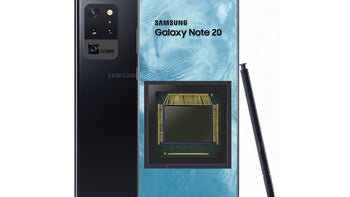Galaxy Note 20+ may solve Samsung's 108MP camera focus issues with a new 50MP sensor

The Note 20+ is most likely getting the Galaxy S20 Ultra camera, which should come as no surprise to anyone even remotely acquainted with Samsung's flagship phone strategies. The second generation 108MP sensor used in the Ultra is unique in that it merges the light information from no less than 9 pixels into one big virtual for unprecedented amount of quality and detail.
Granted, other sensors, including Samsung's own 64MP and 48MP units, do the so-called pixel-binning trick as well, but with four adjacent pixels in a Tetracell, not Nonacell format. The bad part, however, is that Samsung's acclaimed Dual Pixel autofocus system that tags two opposite photodiodes to each and every pixel in a sensor for extremely fast and accurate focusing, has not been used with pixel-binning so far.
Not with the 64Mp ISOCELL Bright GW1, nor with its 48MP ISOCELL Bright GM2 sensors, and not even with the big and expensive 108MP sensor of the Galaxy S20 Ultra. The first Samsung sensor to combine both Dual Pixel autofocus and the Tetracell pixel-binning technology will be brand new 50MP unit that the company just announced, the ISOCELL GN1.
On top of the outstanding focusing abilities, the fresh 50MP sensor comes with large 1.2 micron pixels (2.4 micron in Tetracell mode), compared to the 0.8 (1.6 virtual) micron ones on the current pixel-binners. Thus, Samsung drops several birds with one stone and combines the best low-light performance and focusing technologies currently available on a phone into this new sensor.
Will Samsung use the 50MP camera sensor in the Galaxy Note 20 Plus?
In fact, Samsung's new 1/1.31" sensor announcement sounds similar to what it already in the Huawei P40 Pro, i.e. a large 1/1.28 50MP sensor with 2.4 micron virtual pixels and "omnidirectional" autofocus. If that is indeed the case, then we can expect some stellar night time photography from Samsung phones going forward, judging by what Huawei is capable of with the sensor on the P40 series. According to Yongin Park, executive vice president of sensor business at Samsung Electronics:
With innovative pixel technologies, Samsung has been at the forefront of offering high-performance image sensors that closely cater to increasingly diversifying market needs. The ISOCELL GN1 is part of that commitment to deliver stunning images to consumers in any environment. We will continue to introduce image sensor solutions at the cutting-edge that will lead the next trends in mobile photography.
Samsung says that the sensor has already entered the mass production stage this month, and we can't help but wonder which phone are the conveyor belts churning for. It could be the rumored Oppo X50, of course, if a tailored version of the large 50MP sensor is indeed what's being used for it, as rumored, or it could be something that is coming at a later date. Given the sensor's specs we'd expect that Samsung will place it in a flagship-grade phone first.
Now, what high-end could be coming from Samsung in the next few months? That's right, the Galaxy Note 20 series. Could the 50MP unit be used in the Note 20 or Note 20+ and wouldn't it be an overkill of the Plus model is already confirmed to land with the 108MP main sensor?
Galaxy Note20 + will still use 108mp HM1, but add a new sensor to assist in focusing and completely solve the focusing problem.
— Ice universe (@UniverseIce) May 19, 2020
On the Galaxy S20 Ultra,, Samsung now uses a 48MP secondary sensor for ultrawide angle shots, so swapping it for its first 50MP Dual Pixel kit with Tetracell binning wouldn't be that much of a leap to imagine, if Samsung finds place for it.
The focusing information from the sensor can then be used to enhance the results from the main 108MP juggernaut, preventing the complaints about the Galaxy S20 Ultra autofocus in one fell swoop. We shudder to think about the price of the Note 20+, though, if all that camera jazz indeed goes into it. Samsung has already sacrificed battery capacity to fit the S Pen, though, and an extra giant camera sensor would be a challenge for its engineers to fit.













Things that are NOT allowed: